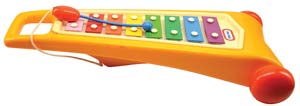Self-control
Toddlers watch a caregiver calm down after getting excited playing a xylophone.



[Invite several toddlers to join you at a low table to listen to the sounds of a musical toy.]
 I have a toy that makes music! It is called a xylophone.
I have a toy that makes music! It is called a xylophone.
[Display toy. Show mallet when you describe it.]
This is a mallet. The toy xylophone will make sounds when I tap it with this mallet.
[Point to your ears.]
Listen to the sounds I can make by tapping the mallet on the xylophone.
[Tap different notes on the xylophone with the mallet. Play a scale or play a few lines of a familiar song. Then pause for toddlers’ possible responses.]
I can make louder sounds with the xylophone. I can make quieter sounds with the xylophone. Please watch how I tap the xylophone with the mallet.
[Tap the same note on the xylophone hard, 2–3 times.]
I made a louder sound. Now I am going to make a quieter sound.
[Tap the same note on the xylophone softly, 2–3 times.]
That makes a nice sound!
[Use an enthusiastic, excited approach to tapping the xylophone repeatedly to provide a mix of louder and quieter sounds.]
I had fun tapping the xylophone to make different sounds. The music makes me feel excited.
It is time for me to calm down. I am going to put the mallet away and rest my body.
[Place the mallet under the xylophone. Use a quiet voice to explain that you are done making music with the xylophone. You are going to do some things to calm down. Relax your arms and put your hands in your lap. Close your eyes briefly. Take several slow, deep breaths. Quietly hum a familiar song.]
I had fun making music on the xylophone. I made louder and quieter sounds with a mallet. I got excited. Then it was time for me to rest my body. I did some things to calm down. Now I feel calm.
Self-control
A toddler practices calming down, with caregiver support, after making music with a xylophone.



 Invite a toddler to join you at a low table to play a musical toy. Introduce the xylophone and briefly demonstrate how to use the mallet to tap the xylophone bars. Demonstrate making louder and quieter sounds. Give the toddler the mallet and encourage him/her to tap the xylophone. Invite the toddler to make louder and quieter sounds, and to use different bars on the xylophone.
Invite a toddler to join you at a low table to play a musical toy. Introduce the xylophone and briefly demonstrate how to use the mallet to tap the xylophone bars. Demonstrate making louder and quieter sounds. Give the toddler the mallet and encourage him/her to tap the xylophone. Invite the toddler to make louder and quieter sounds, and to use different bars on the xylophone.
After 1–2 minutes, explain that the toddler’s music is making you feel excited and that the toddler may feel excited, too. Announce that it is time for us to calm down. Invite the toddler to put away the mallet. Help the toddler practice resting his/her body through demonstration and verbal support as follows:
Acknowledge the toddler’s efforts to calm down. Explain that you are both sitting quietly and resting. You got excited playing and listening to the xylophone. Now we feel calm.
The calming-down strategies suggested in both activity options have been offered in prior activities focused on resting after a period of excitement. What is different in the current plan is the use of the xylophone. Toddlers differ in what excites them. The xylophone is a fun toy for most toddlers, and encouraging a toddler to make louder and quieter sounds and to tap a range of xylophone bars is likely to yield a modest level of excitement. Concentrating on making different types of sounds can be exciting by itself. Some toddlers may focus on their tapping motions, whereas others may listen closely to different sounds as they move up and down the xylophone bars.
The calming-down segment of Option 2 intentionally promotes a “let’s do this together” approach. It is not necessary for a toddler to feel excited in order to practice calming-down strategies. Avoid omitting the calming-down segment if a toddler seems relaxed. There may be a future point when the toddler is truly excited and would benefit from a previously-practiced calming-down routine.
Extra support
Enrichment
Materials Needed: musical instruments—including toy xylophone and shakers, blanket
Place the instruments in a designated part of your room for toddlers to explore. You also may wish to provide practice in following requests to make and stop making music with an instrument by engaging several toddlers at a time in a game of Play and Stop. Use hand signals to tell toddlers when to play and when to stop playing an instrument. Invite toddlers to put their instrument (including xylophone mallet) on the blanket when you offer a stop signal. The blanket will help the instruments become quiet. If you anticipate conflict over who plays the xylophone, encourage toddlers to take turns or do not include the xylophone in the game. Repeat the Play and Stop game several times and then invite toddlers to sit quietly with you to practice calming down before moving to another activity.
Materials Needed: variety of age-appropriate musical instruments
Preschool-age and older children may enjoy joining toddlers for the Play and Stop game suggested for an Interest Area. This game promotes self-regulation skills. Infants will enjoy holding a shaker during the activity. You could use soft, recorded music instead of, or in addition to, hand signals. Provide support for a calming-down period at the end of the game.